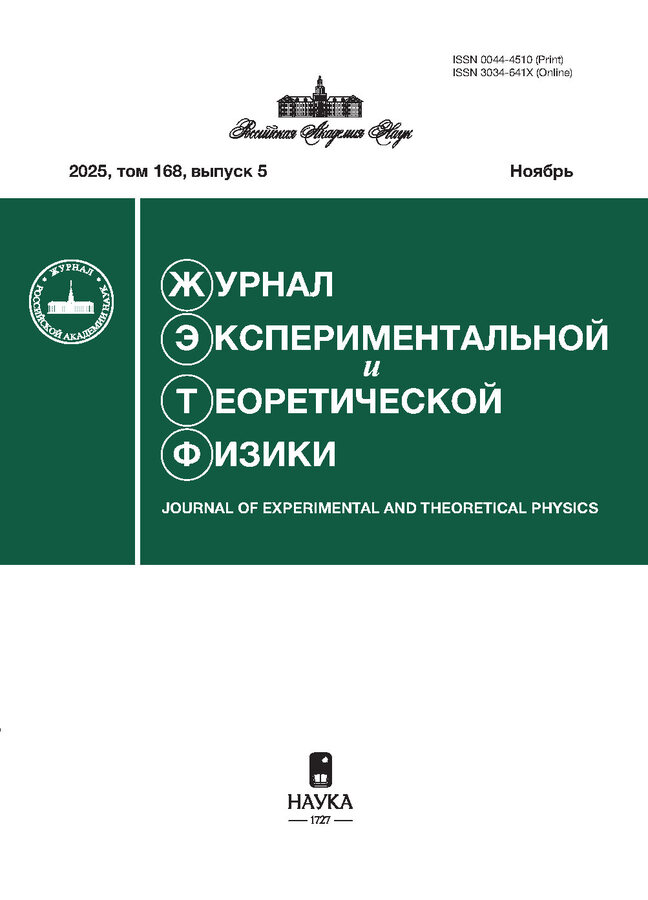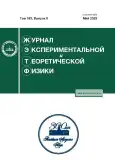Влияние структурных параметров на особенности электронной структуры топологических поверхностных состояний MnBi2Te4
- Авторы: Макарова Т.П1, Шикин А.М1, Ерыженков А.В1, Тарасов А.В1
-
Учреждения:
- Санкт-Петербургский государственный университет
- Выпуск: Том 163, № 5 (2023)
- Страницы: 708-716
- Раздел: Статьи
- URL: https://journals.rcsi.science/0044-4510/article/view/145408
- DOI: https://doi.org/10.31857/S0044451023050097
- EDN: https://elibrary.ru/BENYOQ
- ID: 145408
Цитировать
Полный текст
Аннотация
Экспериментальные исследования электронной структуры антиферромагнитного топологического изолятора MnBi2Te4 показывают, что величина энергетической запрещенной зоны для различных образцов кристалла может варьироваться в широком энергетическом диапазоне. В связи с тем, что величина запрещенной зоны является одним из ключевых параметров при использовании данной системы для разработки новых функциональных электронных устройств, вопросы о причинах вариации запрещенной зоны в точке Дирака для MnBi2Te4 и ее связи с магнитными взаимодействиями являются весьма важными и требуют всестороннего анализа. С целью выявления факторов, влияющих на величину запрещенной зоны, в данной работе проведен анализ изменений электронной структуры исследуемого топологического изолятора при вариации величины поверхностного ван-дер-ваальсова промежутка. Результаты расчетов показали, что при подобных структурных модификациях значение запрещенной зоны может меняться в широком диапазоне от 80-88 мэВ до 4-5 мэВ, что объясняется сильным пространственным перераспределением топологических поверхностных состояний между семислойными блоками MnBi2Te4, имеющими противоположные направления магнитных моментов Mn. Полученные результаты позволяют предположить, что основным параметром, определяющим величину запрещенной зоны, является пространственная локализация топологических поверхностных состояний, на которую могут сильно влиять структурные изменения, происходящие на поверхности кристалла.
Об авторах
Т. П Макарова
Санкт-Петербургский государственный университет
Email: i@tmakarova.ru
198504, St. Petersburg, Russia
А. М Шикин
Санкт-Петербургский государственный университет
Email: i@tmakarova.ru
198504, St. Petersburg, Russia
А. В Ерыженков
Санкт-Петербургский государственный университет
Email: i@tmakarova.ru
198504, St. Petersburg, Russia
А. В Тарасов
Санкт-Петербургский государственный университет
Автор, ответственный за переписку.
Email: i@tmakarova.ru
198504, St. Petersburg, Russia
Список литературы
- X.-Li. Qi, T. L. Hughes, and S.-C. Zhang, Phys. Rev. B 78, 195424 (2008).
- X.-L. Qi and S.-C. Zhang, Rev. Mod. Phys. 83, 1057 (2011).
- C.-Z. Chang, J. Zhang, X. Feng et al., Science 340, 167 (2013).
- Y. Tokura, K. Yasuda, and A. Tsukazaki, Nature Rev. Phys. 1, 126 (2019).
- C. Z. Chang, W. Zhao, D. Kim et al., Nature Mater. 14, 473 (2015).
- M. Gibertini, M. Koperski, A. F. Morpurgo et al., Nature Nanotechn. 14, 408 (2019).
- K. Burch, D. Mandrus, and J.-G. Park, Nature 563, 47 (2018).
- X. Lin, W. Yang, K. L. Wang et al., Nature Electron. 2, 274 (2019).
- T. Jungwirth, X. Marti, P. Wadley et al., Nature Nanotechn. 11, 231 (2016).
- L. Sˇmejkal., Y. Mokrousov, B. Yan et al., Nature Phys. 14, 242 (2018).
- V. Baltz, A. Manchon, M. Tsoi et al., Rev. Mod. Phys. 90, 015005 (2018).
- Y. Deng, Y. Yu, M. Z. Shi et al., Science 367, 895 (2020).
- A. Essin, J. Moore, and D. Vanderbilt, Phys. Rev. Lett. 102, 146805 (2009).
- S. Coh, D. Vanderbilt, A. Malashevich et al., Phys. Rev. B 83, 085108 (2011).
- S.-Y. Xu, M. Neupane, C. Liu et al., Nature Phys. 8, 616 (2012).
- Y. L. Chen, J. H. Chu, J. G. Analytis et al. Science 329, 659 (2010).
- J. G. Checkelsky, J. Ye, Y. Onose et al., Nature Phys. 8, 729 (2012).
- A. M. Shikin, A. A. Rybkina, D. A. Estyunin et al., Phys. Rev. B 97, 245407 (2018).
- A. M. Shikin, D. A. Estyunin, Yu. I. Surnin et al., Sci. Rep. 9, 4813 (2019).
- J. Henk, A. Ernst, S. V. Eremeev et al., Phys. Rev. Lett. 108, 206801 (2012).
- M. M. Otrokov, I. I. Klimovskikh, H. Bentmann et al., Nature 576, 416 (2019).
- D. Zhang, M. Shi, T. Zhu et al., Phys. Rev. Lett. 122, 206401 (2019).
- J. Li, Y. Li, S. Du et al., Science Advances 5, eaaw5685 (2019).
- Y. Gong, J. Guo, J. Li et al., Chin. Phys. Lett. 36, 076801 (2019).
- S. H. Lee, Y. Zhu, Y. Wang et al., Phys. Rev. Res. 1, 012011 (2019).
- Z. S. Aliev, I. R. Amiraslanov, D. I. Nasonova et al., J. Allows Comp. 789, 443 (2019).
- M. M. Otrokov, I. P.Rusinov, M. Blanco-Rey et al., Phys. Rev. Lett. 122, 107202 (2019).
- C. Liu, Y. Wang, H. Li et al., Nature Mater. 19, 522 (2020).
- J. Ge, Y. Liu, J. Li et al., Nat. Sci. Rev. 7, 1280 (2020).
- A. Gao, Y.-F. Liu, C. Hu et al., Nature 595, 52 (2021).
- А. М. Шикин, Д. А. Естюнин, Н. Л. Зайцев и др., ЖЭТФ 161, 126 (2022).
- D. A. Estyunin, I. I. Klimovskikh, A. M. Shikin et al., Appl. Phys. Lett. Mater. 8, 021105 (2020).
- A. M. Shikin, D. A. Estyunin, I. I. Klimovskikh et al., Sci. Rep. 10, 1 (2020).
- A. M. Shikin, D. A. Estyunin, N. L. Zaitsev et al., Phys. Rev. B 104, 115168 (2021).
- Y.-J. Hao, P. Liu, Y. Feng et al., Phys. Rev. X 9, 041038 (2019).
- Y. J. Chen, L. X. Xu, J. H. Li et al., Phys. Rev. X 9, 041040 (2019).
- P. Swatek, Y. Wu, L. L. Wang et al., Phys. Rev. B 101, 161109 (2020).
- D. Nevola, H. X. Li, J.-Q. Yan et al., Phys. Rev. Lett. 125, 117205 (2020).
- C. Yan, S. Fernandez-Mulligan, R. Mei et al., Phys. Rev. B 104, L041102 (2021).
- B. A. Bernevig, C. Felser, and H. Beidenkopf, Nature 603, 41 (2022).
- M. Garnica, M. M. Otrokov, P. C. Aguilar et al., Quant. Mater. 7, 1 (2022).
- А. М. Шикин, Д. А. Естюнин, Д. А. Глазкова и др., Письма ЖЭТФ 115, 241 (2022).
- S. Grimme, J. Antony, S. Ehrlich et al., J. Chem. Phys. 132, 154104 (2010).
- N. Troullier and J. L. Martins, Phys. Rev. B 43, 1993 (1991).
- T. Ozaki, Phys. Rev. B 67, 155108 (2003).
- T. Ozaki and H. Kino, Phys. Rev. B 69, 195113 (2004).
- T. Ozaki and H. Kino, Phys. Rev. B 72, 045121 (2005).
- J. P. Perdew, K. Burke, and M. Ernzerhof, Phys. Rev. Lett. 77, 3865 (1996).
- M. J. Han, T. Ozaki, and J. Yu, Phys. Rev. B 73, 045110 (2006).
Дополнительные файлы










